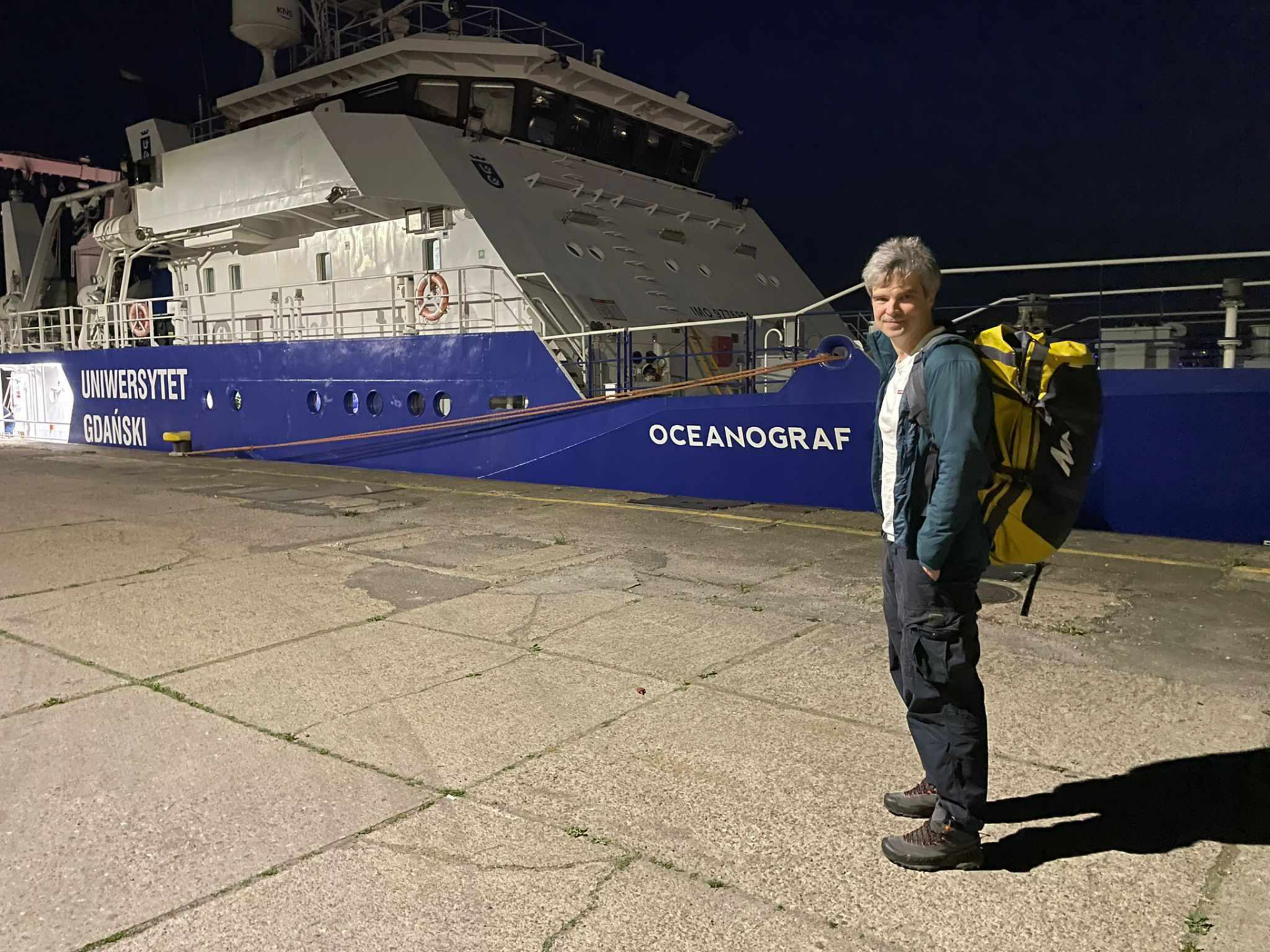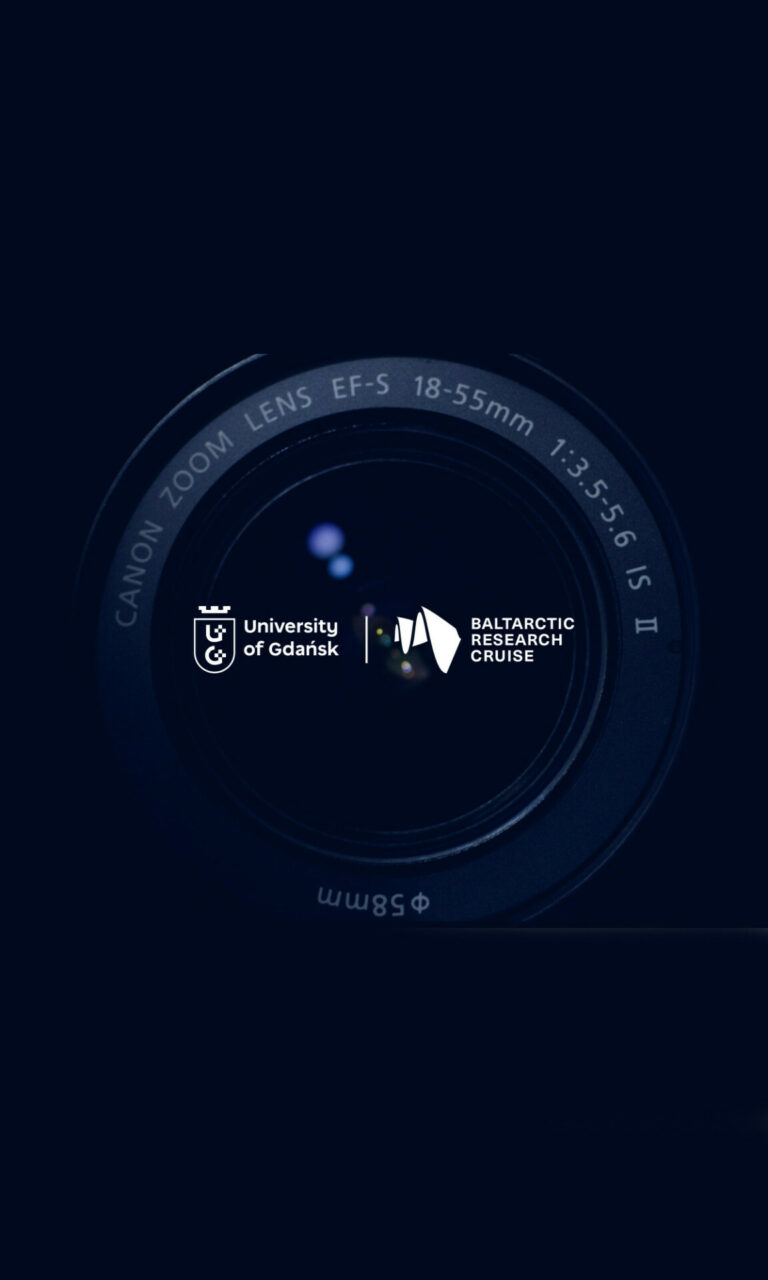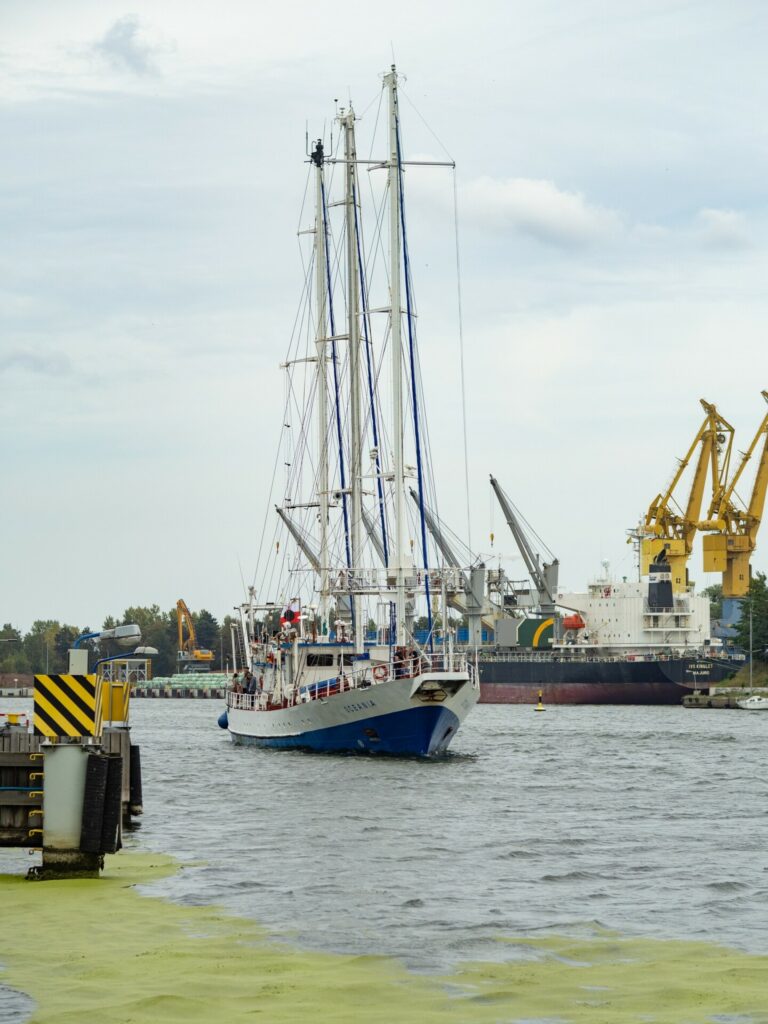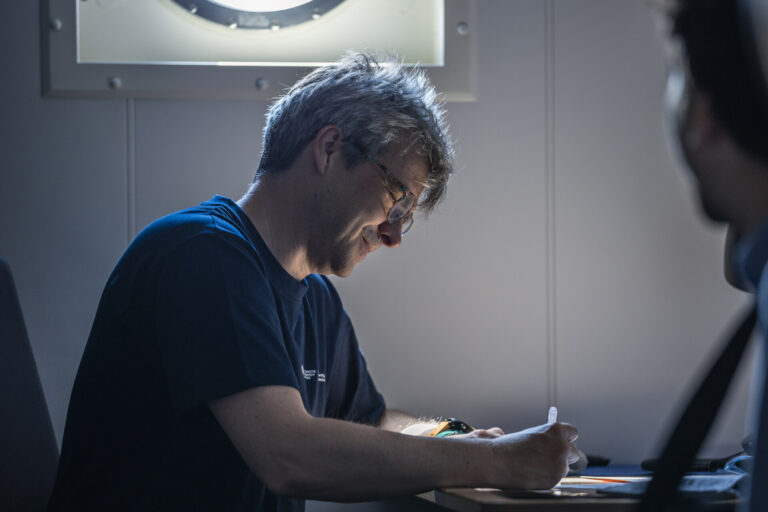It’s Tuesday afternoon on the second day of the cruise. After sailing almost two hundred miles, we pass Bornholm, which allows us to catch Danish coverage for a while and call our families, still 24 hours to Kiel – where the real expedition begins. There is not much wind, the sea is almost flat, a nice change after yesterday evening, when a nasty Baltic swell and twenty knots of wind hit us as soon as we emerged from the protective shadow of the Hel Peninsula.
R/v Oceanograf – to whom I’m looking for a nickname, perhaps Graphy? – was bouncing up and down in the waves, making such sounds as if some prankster had dropped steel containers from a harbour crane onto the concrete time and again. Well, it’s not the first time I’ve seen such weather on the water, we’re not even approaching a storm. As it’s the first day of the cruise, I’m a little nauseous, but I can’t, as an experienced sailor, give up dinner. So I go, the mess hall is empty. So all in all, I don’t have to show off, but it’s stronger than me, I put on a bowl of pasta with spinach, blue cheese and cherry tomatoes.
Delicious. But visually, you understand, see it with your eyes. That’s right.
There are almost twenty of us here, half are sailors, half scientists. Who, what, how and why they research – time will come to describe.
I woke up, pleasantly sleepy from the night’s rocking, with the thought that it is not easy to be an artist today, just as it is not easy to be a scientist. I mean, on the one hand, it’s never been so easy – there’s a university in every county, we have more PhDs than high school graduates, and all you need to do to make your art available to someone is to have a pulse. That is, I don’t mean that there is a high threshold to enter the world of art or science, this threshold today de facto does not exist.
I mean that it’s harder to find meaning in it, knowing that all in all, everything has been discovered and everything has been created. What pushed us all aboard the r/v Oceanograf was probably the same need for adventure that was behind James Cook, setting sail on the HMS Endeavour to draw maps of coasts that Europeans had no idea even existed. Behind Charles Darwin, boarding the HMS Beagle to conduct research that was to revolutionize natural science, and in the process, put God to death. Behind Jules Verne, who created a new type of novel that was a combination of adventure and science, to amaze readers with discoveries and new human capabilities.
And now? Every island to be seen on Google Earth, every inaccessible corner of the planet in a funny reel on Instagram, the smallest bugs catalogued, novels written, paintings painted, symphonies composed, something there can still be remixed, made weird, made the same for a new audience. But probably all the sailors, scientists and writers present on this ship know that although they will add their brick to the edifices of science and art – they will be ornaments, not foundations.
Intellectually I understand this, sure. But the heart in me dances, because I, after all, could not tear myself away from Verne’s novels, these adventures were so fantastic and so huge that it was unbearable. And now – like his heroes – I set out as a steel-eyed adventurer, together with intrepid scholars and bearded sea wolves into the unknown, to rip the world of its secrets.
Let’s stick to that.
R/V Oceanograf
BaltArctic Research Cruise, Day 2
June 4, 2024
Stalowe spojrzenia
Fale za Przylądkiem Rozewie • Szpinak i choroba morska • Mijamy Bornholm • Nieznane wydaje się znane, ale i tak się jaramy
Jest wtorkowe popołudnie drugiego dnia rejsu. Po przepłynięciu prawie dwustu mil mijamy Bornholm, co pozwala nam złapać na chwilę duński zasięg i zadzwonić do rodzin, do Kilonii – gdzie zaczyna się prawdziwa ekspedycja – jeszcze doba drogi. Wieje niewiele, morze prawie płaskie, miła odmiana po wczorajszym wieczorze, kiedy wstrętna bałtycka fala i dwadzieścia węzłów wiatru uderzyły w nas tradycyjnie jak tylko wyszliśmy z ochronnego cienia Półwyspu Helskiego.
Oceanograf – któremu szukam pieszczotliwej nazwy, może Grafik? – podskakiwał i spadał w dół fali, wydając takie dźwięki, jakby jakiś żartowniś raz po raz zrzucał z portowego dźwigu stalowe kontenery na beton. No spoko, myślę, nie pierwszy raz taka pogoda na wodzie, do sztormu nawet się nie zbliżamy. Jak to pierwszego dnia rejsu, trochę mdli, ale nie mogę jako doświadczony żeglarz zrezygnować z kolacji. Więc idę, mesa pusta. Czyli w sumie nie muszę się popisywać, ale to mocniejsze ode mnie, nakładam michę makaronu ze szpinakiem, serem pleśniowym i pomidorkami cherry.
Przepyszne. Ale wizualnie, rozumiecie, zobaczcie to oczami wyobraźni. No właśnie.
Jest nas tutaj prawie dwadzieścia osób, połowa to marynarze, połowa naukowcy, naukowczynie raczej. Kto, co, jak i po co bada – przyjdzie czas opisywać.
Obudziłem się, miło wyspany nocnym bujankiem, z myślą, że nie jest łatwo być dziś artystą, tak samo jak nie jest łatwo być naukowcem. To znaczy z jednej strony nigdy nie było to tak proste – uniwersytet ma każdy powiat, doktorów mamy więcej niż maturzystów, a żeby udostępnić komuś swoją twórczość to serio, wystarczy mieć puls. Czyli nie chodzi mi o wysoki próg wejścia w świat sztuki lub nauki, ten próg dziś de facto nie istnieje.
Mam na myśli, że trudniej w tym znaleźć znaczenie, wiedząc, że w sumie wszystko zostało odkryte i wszystko zostało stworzone. Na pokład Oceanografu wepchnęła nasz wszystkich pewnie ta sama potrzeba przygody, która stała za Jamesem Cookiem, wypływającym na HMS Endeavour, żeby narysować mapy wybrzeży, o których Europejczycy nie mieli pojęcia, że w ogóle istnieją. Za Charlesem Darwinem, wsiadającym na pokład HMS Beagle, żeby przeprowadzić badania, które miały zrewolucjonizować nauki przyrodnicze, a przy okazji uśmiercić Boga. Za Julesem Vernem, który uznał, że stworzy nowy typ powieści, będącej połączeniem przygody i nauki, żeby zadziwić czytelników odkryciami i nowymi możliwościami człowieka.
A teraz? Każda wysepka do obejrzenia na Google Earth, każdy niedostępny zakątek planety w śmiesznej rolce na Instagramie, najmniejsze robale skatalogowane, powieści napisane, obrazy namalowane, symfonie skomponowane, coś tam można jeszcze zremiksować, udziwnić, zrobić to samo dla nowej publiczności. Ale pewnie wszyscy obecni na tym statku marynarze, naukowcy i pisarze (sztuk jeden) wiedzą, że chociaż dołożą swoją cegiełkę do gmachów nauki i sztuki – to będą to ornamenty, a nie fundamenty.
Intelektualnie to rozumiem, jasne. Ale serce we mnie tańczy, bo ja przecież nie mogłem się oderwać od powieści Verne’a, te przygody były tak fantastyczne i tak ogromne, że aż nie do zniesienia. A teraz – jak jego bohaterowie – wyruszam jako poszukiwacz przygód o stalowym spojrzeniu, razem z nieustraszonymi uczonymi i brodatymi wilkami morskimi w nieznane, wydrzeć światu jego tajemnice.
Tego się trzymajmy.
R/V Oceanograf
BaltArctic Research Cruise, Dzień 2
4 czerwca 2024





